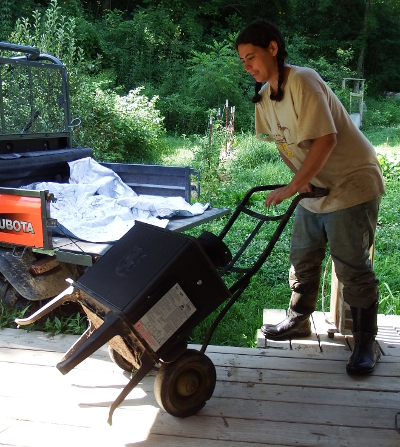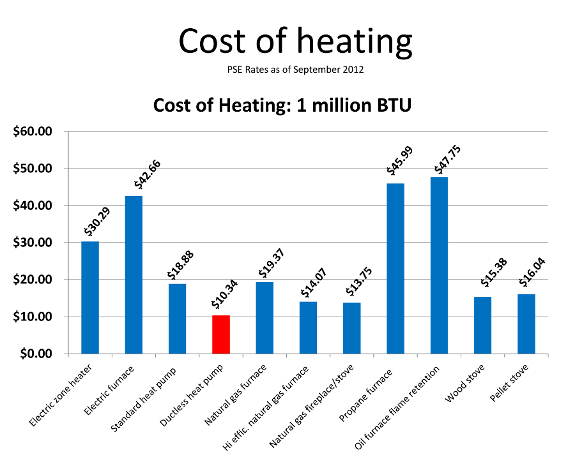
Energy and cost effective heating and cooling for small spaces
 Our
new trailer has no
furnace and we're not sure if we'll get our wood stove installed and
find cured fuel before winter. So now seemed to be the time to get our
act in order about a backup heat source.
Our
new trailer has no
furnace and we're not sure if we'll get our wood stove installed and
find cured fuel before winter. So now seemed to be the time to get our
act in order about a backup heat source.
Mark's first impulse was
geothermal since this is the most efficient heating and cooling option
currently available. Of course, the downside of geothermal is a hefty
price tag. The internet reports that you can install a geothermal
system for as little as $7,000, but my on-the-ground research showed up
$20,000 as the more-likely lower limit. Given the small size of our
space, the current lack of federal tax rebates, and the fact that a
considerable amount of our heat will likely be wood in the long term,
that price tag seemed unrealistic. So I moved on down the list to heat
pumps.
The last time I read
about the heat-pump option, it didn't seem realistic for our region
since heating efficiencies dramatically decline in cold weather. But
since then, science has come to the rescue with variable-speed heat
pumps that don't start losing their efficiency until 5 degrees
Fahrenheit. Plus, if your home is smaller than 1,000 square feet,
ductless heat pumps bring efficiency levels nearly to geothermal status
for a much lower price tag. For example, this
2,400 BTU unit costs
$1,374 (or $947 after Mark's veteran's discount and AEP Ohio's $300
rebate) while boasting operating costs that rival those of a wood stove
if you're buying fuel.
I can just hear Mom
asking, "But what about the noise?" Ductless heat pumps use circulating
refrigerants rather than moving air, so they're much quieter than the
less efficient standard heat pumps. All told, they're currently top of
our list...but I'd love to hear from anyone who's given them a try and
has firsthand information to impart!
Want more in-depth information? Browse through our books.
Or explore more posts by date or by subject.
About us: Anna Hess and Mark Hamilton spent over a decade living self-sufficiently in the mountains of Virginia before moving north to start over from scratch in the foothills of Ohio. They've experimented with permaculture, no-till gardening, trailersteading, home-based microbusinesses and much more, writing about their adventures in both blogs and books.
Want to be notified when new comments are posted on this page? Click on the RSS button after you add a comment to subscribe to the comment feed, or simply check the box beside "email replies to me" while writing your comment.


Anna, we are in Ontario, Canada and had an air source heat pump installed a few years ago. Our house is small, about 640 square feet. We love it. It starts providing us with heat early in the spring, then into the summer it provides us with cool, dryer air for sleeping during heat waves, then in the autumn it provides us with heat into October, and on milder days right into December.
Our hydro bills are high, but not much higher than they were before the heat pump was installed. Hydro in Ontario, Canada is very, very expensive, so we were pleased that during peak usage, our heat pump costs roughly $50 a month to run, our hydro bills have always cost about $100 a month for bare minimum usage. Here in Ontario most of the bill is delivery, and debt repayment, the actual energy portion of bill is the smallest portion.
When we heated with wood, and purchased hardwood, we spent approximately $1000 per heating season on fuel. Just to give you a basis for comparison.
Anna,
Heat pumps are often done in combination with horizontal shallow underground collectors. At least here in the Netherlands.
I put some info in this comment on the hybrid heater article.
Those are very effective in winter, because the soil temperature doesn't dip as low as air temperature. Of course, your collector has to be buried below the frost line.
We have looked at and considered a ductless heat pump but to be honest we love, love, love our pellet stove. After more than 20 years with wood heat we moved to an all electric home. A home in which I froze for more than a decade because electric heat is expensive! Enter "Harmie"
Due to the homes configuration there was no place to put a conventional wood stove but we had options for easy and cheap installation of a pellet stove as they can vent through a SIDE wall. We heat an 1175 square foot manufactured home in a cold, snowy and wet location in the Foothills of the Oregon Cascades for about $400 a year- a rreally bad year with an extended cold season cost us $600. And we are warm, gloriously warm. The same warmth as a wood stove without the dirt, need for a wood shed and way less effort to put the fuel in each season.
Granted, during power outages we need to run a generator because it takes 165 watts to turn the auger and blower on the stove but that is a "doable" future solar project and you would need a generator to run a ductless heat pump. We consider it a huge plus that we are using what would have been wood waste as our pellets are produced from the waste of a saw mill.
Anna,
On the page you link to I only see 5 °F mentioned in the context of “cooling operations”. I can't find a minimum outside temperature where it can still work as a heater on that page.
According to the spec sheet [PDF] from what seems to be this model, it can heat from an outside temperature of -13 °F, which is quite impressive.
But when it is very cold outside, efficiency will suffer a lot. According to the temperature chart [PDF], when the outside temperature is 5 °F, and the inside temperature is 60 °F, it will yield 19200 Btu/hr. That is approximately 5.6 kW of heat, for an electricity input of 2.39 kW. So the COP is 2.35.
When the outside temperature is 32 °F, is gives 20450 Btu/hr with a power use of 2.22 kW. That is a COP of 2.7. If you want to heat your house to like 70 °F, efficiency drops even further.
So in the winter, I think that you should realistically reckon that you get about twice the electric input power as heating power.
We purchased an MSeries 36,000 BTU Dual TriQuad Zone Mini Split Outdoor Condenser Heat pump and four indoor wall mounted units (one 15,000 BTUs for the larger main room; one 12,000 BTUs for the kitchen and eating area; two 6,000 BTUs units, one for each bedroom) two years ago from an on-line company called eComfort.com. Total cost was under $5,000 for everything including the piping, insulation, etc. (no shipping charge). My husband installed everything himself but we did get a certified technician to come and verify proper installation so the warranty would be in effect. We have been very pleased with this system. The A/C in summer is amazing--very comfortable no matter how hot and humid. The winter heating is great, but it does feel cooler in the house when the temps start dipping in the low 20's (main room has lots of windows and is not yet well insulated so that no doubt has an affect). Can't give much info on cost comparison to other systems since we heated totally with wood prior to the installation and we did not live here full time previously. The system is very quiet, both the outside unit as well as the inside units. We really like that you can set each room's temperature separately, so for example if one likes to sleep in a cooler room you can set that temperature lower than the rest of the house. If we had it to do over, we would purchase the same unit again.
If you decide to purchase through Home Depot, I would suggest you verify with them prior to the purchase that they will indeed allow the veteran's discount (if that is a large part of your choice). We have recently had issues with Home Depot not allowing discounts on things they had previously honored. We have had no such problem with Lowe's however.
Good luck!